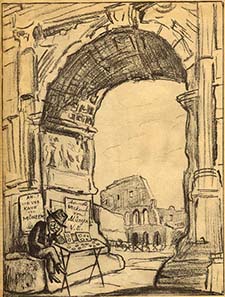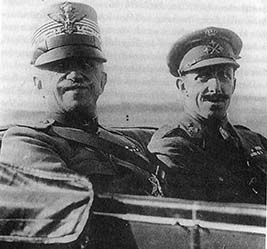In celebration of the publication of CNI’s 1st volume
In edition 26 of the Nebelspalter from the war year 1944 a caricature was shown that poses a riddle to the inexperienced reader of today.
Caricature in the Nebelspalter from June 1944.
A low-spirited man sits behind a small sales counter in front of the Arch of Titus in Rome. One is obliged to regard him as a simple street seller, one of them that impose trashy souvenirs on tourists. On a poster the man reveals what he is trading in: purchase and sale of coins. Below one can read: sic transit gloria – that is how glory passes by. Close inspection explains the motto: the unhappy coin dealer can be identified by his initials V. E. and his prominent facial features as Victor Emmanuel, third King of Italy bearing that name. What, one wonders instantly, is behind that caricature which in June 1944 obviously every reader of the Nebelspalter was able to decipher? Victor Emmanuel III ruled Italy from July 29th, 1900, to May 9th, 1946. That was a challenging task that, one is inclined to think, fully occupies a man. But Victor Emmanuel was King only by occupation, his real calling was numismatics. He spent every minute assembling a coin collection. Which coins does the King of Italy collects? What a question – the coinage of every Italian mint since the Migration Period, of course. Victor Emmanuel is said to have carried together roughly 120,000 pieces. With pride he pointed out with every sale that he financed the coin purchases from his privy purse only. They were therefore his private property and not a family heirloom of the Casa Savoya or even state property.
Around the turn of the century coin collecting was still a difficult task to undertake because there was only a small number of catalogues published. And what does a collector do when lacking a catalogue? Exactly, he writes one himself. The catalogue by Victor Emmanuel, entitled “Corpus Nummorum Italicorum“, comprises 19 volumes that are the standard reference on Italian coinage until the present day. To give an impression, the first volume was published in 1900 in 600 copies containing 532 pages with 5,354 catalogued coins of which at least 715 were depicted. To celebrate that great achievement, the Italian Numismatic Association appointed the King honorary president. Until his death, the Royal numismatist managed to provide studies on almost every Italian province except for the Naples Mint after Charles V and the coinage of the island of Sicily.
Victor Emmanuel III, King of Italy, and Alfons XIII, King of Spain.
The work that prospering is almost a miracle since Victor Emmanuel was fully committed to his country’s political events at the same time. Although the King worked together with Mussolini for years, he nevertheless had his agenda in behoof of his country and the Casa Savoya. That became especially clear in spring 1943. A number of defeats let become Nazi Germany’s ultimate victory doubtful and the Italian King desperately looked for prospects of concluding a separate peace with the Allied Forces. He was afraid of the Germans taking the defence in their own hands when the Allied Forces invaded Italy. In that case, Italy would have been at the mercy of the National Socialists. Göring constantly visiting Mussolini let the King conclude that the preparations of the German takeover of Italy were almost completed. When in May 1943, after the German defeat in Tunisia, the Allied landing was imminent, the King acted. He convinced leading politicians of the Fascist Grand Council to vote on July 24th, 1943, for the reintroduction of the democracy under a constitutional monarchy. Apart from that, the King was transferred the military high command. The next day, Victor Emmanuel summoned Mussolini in his palace to remove him from his offices. “Dear Duce”, the King is said to have remarked, “we can’t continue like that. Italy is breaking apart. The soldiers refuse to fight… At present, you are Italy’s most hated man.” Mussolini replied laconically: “I wish my successor good luck“, and left the scene in an ambulance.
ITALY. Victor Emmanuel III, 1900-1946. 100 Lire 1923, Rome. From auction Gorny & Mosch 188 (2010), 4198.
Hence, it seemed that the time for the King had come, but of course Hitler could not put up with that arbitrary act of an ally. The German troops invaded Italy and seized Rome. In the very last second, the King and his family had managed to resort to Allied protection with which a treaty had been negotiated on the unconditional surrender of the Italian forces on September 3rd, 1943.
During the following months, the Italian numismatists faced the cussedness of German censorship. The Rivista Italiana Numismatica was objected to. It seems hard to imagine numismatic papers containing any subversive messages but the censors nevertheless insisted that the numbers 77, 84 and 100 of the catalogue raisonné of Dottore G. G. Belloni’s orbituary had to be blackened. Why was that? Well, the man had reviewed the Corpus Nummorum Italicorum, and his review’s caption included the words di S. M. il Re“ (= CNI of his Majesty the King). That was unthinkable! The King had to disappear from numismatics. For the same reason, the first page of the Rivista had to be printed again – it was not opportune anymore to call the honorary president Victor Emmanuel by name.
Italian numismatics (and the local population) was fortunate just the same. On June 4th, 1944, the Allied Force managed to take over Rome. The way was free for the King to rule again but, in order to do that, he would have had to explain himself to his allies. He did not want to do that anymore. Instead, he appointed his son Umberto governor-general. That is the situation the Nebelspalter caricature refers to: for the smiling reader it pictures the career options the resigning King had from then on.
Apart from that, the significant coin collection was stolen by the German occupying troops and it remained missing for many years, even after the war was already over. From the orbituary of Victor Emmanuel, published in RIN 1949 , who died on December 28th, 1947, it can be learned that the collection was found – in which Italian museum the collection is hidden today this article’s author was not able to spot. May be a reader can be of service?
It is perhaps also an interesting enterprise to spend the next holiday in the big coin cabinets in Italy to search for the collection of the King who had donated it to the Italian government on May 9th, 1946.
We thank the “Nebelspalter“ magazine for allowing us to publish the caricature from 1944. If you like to find out more about the magazine which continues to be published click here.






